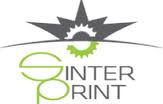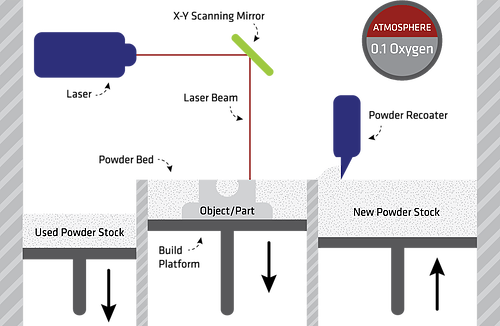 If the gold rush, the green rush, fourteeners galore, and epic skiing, hiking, camping, and fishing had not already put the rugged state of Colorado on the map long ago, 3D printing might be a major consideration. This wonderful state I live in is home to some of the most active, fit people you will find in the US, but as everyone is busy running, mountain biking, mountain climbing, and far more, there’s also a lot of actual work—and innovation—going on behind the scenes too. From Loveland’s highly successful Aleph Objects and their LulzBot lineup of 3D printers to medical centers offering innovative treatments, plus research studies, education, and of course artistic inspiration, the state of Colorado seems to come up quite often in regards to 3D technology.
If the gold rush, the green rush, fourteeners galore, and epic skiing, hiking, camping, and fishing had not already put the rugged state of Colorado on the map long ago, 3D printing might be a major consideration. This wonderful state I live in is home to some of the most active, fit people you will find in the US, but as everyone is busy running, mountain biking, mountain climbing, and far more, there’s also a lot of actual work—and innovation—going on behind the scenes too. From Loveland’s highly successful Aleph Objects and their LulzBot lineup of 3D printers to medical centers offering innovative treatments, plus research studies, education, and of course artistic inspiration, the state of Colorado seems to come up quite often in regards to 3D technology.
And that trend just seems to be accelerating, with the latest announcement regarding Sinter Print of Erie (north of Denver), making a major move in joining ADAPT, the Alliance for the Development of Additive Processing Technologies. Sinter Print had its beginnings as founder and president Jacob Nuechterlein, with a PhD in Powder Material Science from the Colorado School of Mines, began his ‘experiment’ delving into the world of 3D printing. Today, his company specializes in both research and development regarding additive manufacturing, with a focus on ultra materials such as metal, ceramics, and composites.
 Now Sinter Print will be offering their talents in the research consortium that is ADAPT. Dedicated to 3D printing in metal, ADAPT focuses on propelling the technology further for certification and qualification of 3D printed metal parts. As ADAPT’s newest member, Sinter Print certainly offers expertise right in line with the consortium’s goals.
Now Sinter Print will be offering their talents in the research consortium that is ADAPT. Dedicated to 3D printing in metal, ADAPT focuses on propelling the technology further for certification and qualification of 3D printed metal parts. As ADAPT’s newest member, Sinter Print certainly offers expertise right in line with the consortium’s goals.
“We are really excited about our newest member, Sinter Print,” said ADAPT Technical Director Aaron Stebner. “The company embodies the 3D metals printing R&D spirit of our center, and is an incredible complement to the activities going on at the ADAPT Advanced Characterization Center at Mines. With their focus on developing better materials for 3D printing, and our focus on the data informatics needed to efficiently qualify new materials, processes, and parts, this will undoubtedly be a strong partnership going forward. The Sinter Print partnership brings not only new industry input, but also new R&D capabilities to ADAPT.”
“It’s exciting to be on the cutting edge as additive manufacturing goes from infancy to coming of age,” added Nuechterlein. “We believe working with ADAPT will significantly advance manufacturing capabilities across many industries. We see additive manufacturing as a key tool to control costs and drive innovation, and we know that its broader application will benefit people around the world.”
ADAPT, headquartered in Gold, Colorado, continues to seek new resources as they forge ahead with their work, hoping to find other new partners in both the academic and industrial realms who can both ‘support and contribute’ in terms of additive manufacturing research in areas such as:
- Advanced structure-property characterizations of metals using sub-micron-resolved computed tomography (CT)
- Diffraction contrast tomography
- Thermomechanical testing
- 3D surface metrology
- Optical microscopy
Their membership with ADAPT will be an important part of their work today, explained Patrick Callard, business development director of Sinter Print. Because they have such a focus on development of materials, they will be able to further efforts in expanding knowledge about 3D printing, which should as a result offer more significant acceptance of the technology within industry and manufacturing, as well as adoption of the new tools and techniques.
“The better we understand these materials and how to use them consistently, the more confidence we’ll have in current and future materials,” said Callard.
ADAPT currently has research underway on more than 5,000 specimens with respect to build geometry, power, speed, number of lasers used, and more, all being used to build a robust database. The consortium was founded in 2015 through a grant from the Colorado Office of Economic Development and International Trade (OEDIT) through their Advanced Industries.
Several levels of membership to the ADAPT consortium are available. Founding industry members include Ball Aerospace & Technologies Corp., Faustson Tool, Lockheed Martin, and Citrine Informatics. Grant funding from the Colorado Office of Economic Development & International Trade (OEDIT) was provided to Manufacturer’s Edge and The National Institute of Standards and Technology’s Hollings Manufacturing Extension Partnership. For more information, find ADAPT online, at LinkedIn, Facebook, or Twitter. Discuss further in the ADAPT & New Member Sinter Print forum over at 3DPB.com.
Subscribe to Our Email Newsletter
Stay up-to-date on all the latest news from the 3D printing industry and receive information and offers from third party vendors.
You May Also Like
Precision at the Microscale: UK Researchers Advance Medical Devices with BMF’s 3D Printing Tech
University of Nottingham researchers are using Boston Micro Fabrication‘s (BMF) 3D printing technology to develop medical devices that improve compatibility with human tissue. Funded by a UK grant, this project...
3D Printing Webinar and Event Roundup: April 21, 2024
It’s another busy week of webinars and events, starting with Hannover Messe in Germany and continuing with Metalcasting Congress, Chinaplas, TechBlick’s Innovation Festival, and more. Stratasys continues its advanced training...
3D Printing Webinar and Event Roundup: March 17, 2024
It’s another busy week of webinars and events, including SALMED 2024 and AM Forum in Berlin. Stratasys continues its in-person training and is offering two webinars, ASTM is holding a...
3D Printed Micro Antenna is 15% Smaller and 6X Lighter
Horizon Microtechnologies has achieved success in creating a high-frequency D-Band horn antenna through micro 3D printing. However, this achievement did not rely solely on 3D printing; it involved a combination...































